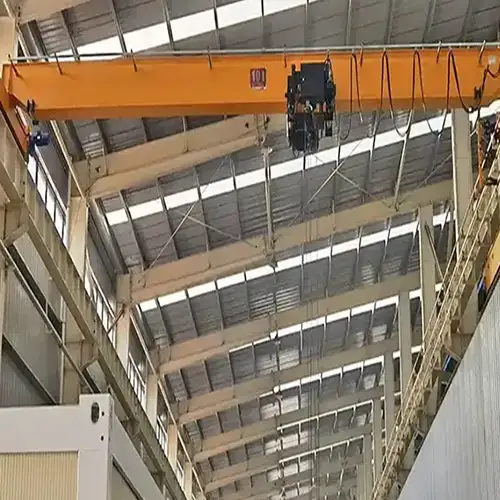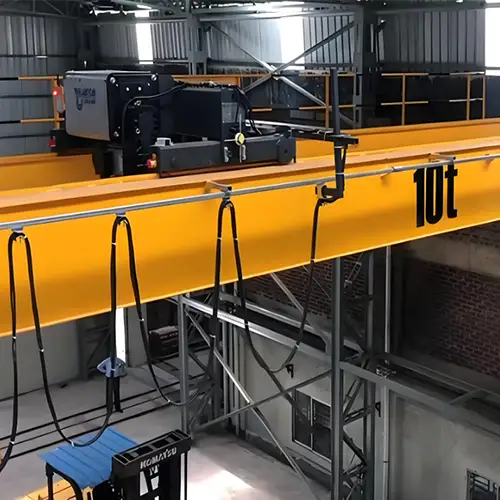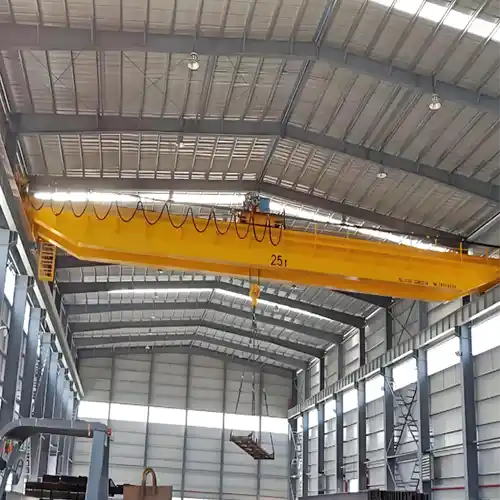Your Trusted Overhead Crane Manufacturer & Supplier
Overhead Crane & Gantry Crane Capacities 5 Ton, 10 Ton , 20 Ton, 32 Ton to 50 Ton
Hot Sale Capacity Overhead Cranes & Gantry Cranes Designs, Options, & Specs
Hot sale overhead & gantry cranes with capacity of 5 ton, 10 ton, 15 ton, 20 ton, 32 ton, 40 ton, 50 ton up to 100 ton. Check designs, options, & specs.Explore essential crane capacities for overhead and gantry cranes, enhancing safety and productivity across various industrial applications.
Importance of Crane Capacity in Industrial Applications
Crane capacity is fundamental to the success of lifting operations in various industries. It determines how much weight a crane can safely lift and move, which directly impacts safety and efficiency.
- Safety Assurance: Selecting a crane with the appropriate capacity helps prevent overloading, which can lead to accidents, equipment damage, or injuries.
- Operational Efficiency: Proper capacity allows for smoother workflows, reducing downtime associated with load failures or equipment malfunctions.
- Cost Management: Choosing the right crane capacity minimizes maintenance costs and extends the lifespan of the equipment, leading to better long-term investments.
Crane capacity is crucial for businesses engaged in heavy lifting. It ensures that tasks are completed safely and efficiently, promoting a productive work environment.
Overview of Hot Sale Capacities in the Market
This guide highlights the most sought-after crane capacities that are frequently sold and utilized across various sectors. These "hot sale" capacities are popular due to their versatility and effectiveness in different applications.
Common Capacities:
- 1 to 3 Ton : ideal for light duty material handling, which will be talked in small and light duty crane section.
- 5 Tons: Ideal for small manufacturing facilities and light construction projects.
- 10 Tons: Frequently used in automotive plants and metalworking shops for moderate lifting tasks.
- 15 Tons: Suitable for industries like steel production and heavy-duty material handling.
- 20 Tons: Commonly found in large manufacturing plants and foundries for lifting heavier equipment.
- 30 Tons to 50 Tons: Used in heavy construction, shipbuilding, and other industrial applications requiring substantial lifting power.
- Above 50 Ton Crane: Used for heavy duty material handling, which will be talked on heavy duty cranes sections .
By focusing on these popular capacities, this guide provides practical insights into their applications, helping businesses choose the right crane for their specific lifting needs. The characteristics and uses of these capacities ensures that operations run smoothly and safely.
Baiscs on Crane Capacity
Definition of Crane Capacity
Crane capacity is the maximum weight that a crane can safely lift and maneuver during operations. This measurement is essential for ensuring that the crane operates within safe limits, preventing accidents and equipment damage. When selecting a crane for a specific lifting task, understanding its capacity is critical for maintaining safety and efficiency in the workplace.
- Safety Considerations: Operating a crane beyond its capacity can lead to structural failure, tipping, or dropping loads, posing serious risks to personnel and equipment.
- Task Suitability: Knowing the capacity helps in choosing the right crane for the job, ensuring it can handle the required loads effectively without strain.
Common Units of Measurement
Crane capacities are measured in various units, depending on the region and industry standards. The se units is vital for accurate equipment selection.
- Pounds (lb):Widely used in the United States for specifying crane capacity.Example: A crane rated at 10,000 pounds can lift 5 tons (as 1 ton equals 2,000 pounds).
- Short Tons (tons):Standard measurement in the U.S. and CanadOne ton equals 2,000 pounds, making it easier for industries to relate crane capacities to common weight standards.
- Metric Tonnes (tonnes):Used internationally, particularly in countries that follow the metric system.One metric tonne equals 1,000 kilograms or approximately 2,204.62 pounds. This unit is essential for ensuring compatibility in global operations.
Your Trusted Overhead Crane Manufacturer & Supplier
Hot Sale Crane Capacities and Typical Crane Designs and Applications
5 Ton Crane Designs and Options
5 ton cranes are widely used in various industries for general load handling tasks. Their lightweight design and efficient operation make them ideal for lifting materials in warehouses, workshops, and assembly lines. These cranes offer excellent maneuverability, allowing for flexible use in tight spaces.
Hot Sale Crane Design Options for 5 Ton Load Handling
Featured Crane Designs for 5 Ton Weights Handling
Portable Gantry Cranes
- Description: Versatile and easily movable, perfect for temporary lifting requirements.
- Applications: Ideal for maintenance tasks and construction sites needing flexibility.
Single Girder Overhead Cranes and Gantry Cranes
- Description: Lightweight and efficient, ideal for small to medium lifting tasks.
- Applications: Commonly used in manufacturing and warehouses for material handling.
Double Girder Overhead Cranes and Gantry Cranes
- Description: Enhanced strength and stability, suitable for heavier loads and larger spans.
- Applications: Frequently found in heavy-duty industries like automotive and steel fabrication.
Semi-Gantry Cranes
- Description: Combines features of gantry and overhead cranes, tailored for specific operational layouts.
- Applications: Often used in workshops for various lifting operations.
Pillar Mounted Jib Cranes
- Description: Fixed to a column, allowing for rotational movement to lift materials.
- Applications: Commonly utilized in assembly areas and maintenance tasks.
10 Ton Cranes Designs and Options
10 ton cranes provide a step up in lifting capacity, making them suitable for heavier loads and more demanding applications. Commonly utilized in construction, manufacturing, and shipping, these cranes combine strength and stability, ensuring safe and efficient material handling. Their versatility makes them a preferred choice for both overhead and gantry crane designs.
Hot Sale Crane Design Options for 10 Ton Load Handling
Featured Crane Designs for 10 Ton Weights Handling
Single Girder Overhead Cranes and Gantry Cranes
- Description: Cost-effective solutions for medium-weight tasks, ensuring smooth operations.
- Applications: Suitable for assembly lines and general material handling.
Double Girder Overhead Cranes and Gantry Cranes
- Description: Offers superior lifting capabilities and stability for heavier loads.
- Applications: Employed in heavy industries, including construction and manufacturing.
Pillar Mounted Jib Cranes
- Description: Allows for 360-degree rotation with a robust design, supporting heavy lifting.
- Applications: Effective in workstations where space optimization is key, commonly seen in factories and repair shops.
15 Ton Crane Designs and Options
Hot Sale Crane Design Options for 15 Ton Load Handling
Design Options:
- Double Girder Overhead Crane: This design enhances strength and stability, making it suitable for heavier lifting tasks.
- Electric Hoist Trolley: Equipped for efficient lifting operations, ensuring smooth and precise movements.
- Open Winch Trolley: Provides versatility in load handling, accommodating various lifting needs.
- Specialized Single Girder Crane Designs: Options include single girder bridge cranes and single girder goliath cranes for specific applications.
Typical Applications:
- Ideal for manufacturing facilities and warehouses where moderate to heavy materials need to be move
- Commonly used in assembly lines, shipping yards, and construction sites for handling components such as steel beams and large machinery.
20 Ton Crane Designs and Options
Hot Sale Crane Design Options for 20 Ton Load Handling
Design Options:
- Double Girder Crane Design: Offers the highest level of stability and capacity, ideal for demanding lifting tasks.
- Electric Hoist Trolley or Open Winch Trolley: Both options facilitate effective load management, with selection based on specific operational requirements.
- Single Girder Crane Design: While less common for this capacity, single girder cranes can be configured for 20 tons, especially in environments with height restrictions.
Typical Applications:
- Frequently found in large industrial settings, such as steel mills and shipyards, where heavy loads are commonplace.
- Utilized in heavy equipment maintenance and assembly, as well as in logistics for loading and unloading shipping containers.

20 ton gantry crane double girder
Featured 15 Ton to 20 Ton Crane Design Options
Double Girder Overhead Crane:
- Description: This design includes two beams, providing superior strength and load-bearing capacity.
- Advantages: Perfect for heavy-duty applications, allowing for greater spans and enhanced lifting capabilities.
- Applications: Common in manufacturing plants, heavy assembly lines, and construction sites.
Double Girder Gantry Cranes
- Description: Gantry cranes provide mobility and flexibility, operating on ground tracks.
- Advantages: Ideal for outdoor use and situations where overhead support structures are not feasible.
- Applications: Often used in construction, shipping, and various industrial applications for moving heavy loads.
Single Girder Overhead Crane and Gantry Cranes
- Description: Features a single beam but can be designed to handle heavier loads with the right specifications.
- Advantages: More economical for specific lifting tasks and suitable for areas with limited headroom.
- Applications: Best for lighter duty manufacturing operations, workshops, and other environments where space is at a premium.
Typical Applications for Overhead Cranes by Capacity
- 15 Ton Capacity:Suitable for moving heavier machinery and components in industrial settings.Commonly used in automotive manufacturing, metalworking shops, and maintenance facilities for handling substantial loads.
- 20 Ton Capacity:Essential for operations that require lifting extremely heavy loads, such as construction and steel fabrication.Frequently utilized in large-scale logistics operations for transporting and positioning hefty materials.
These crane capacities and designs play a crucial role in enhancing operational efficiency and safety, ensuring that industries can effectively manage their lifting and transportation needs.
30 Ton to 50 Ton Crane Designs and Opitons
In the range of 30-ton to 50-ton cranes, double girder designs are typically preferred for material handling across various industrial applications. This capacity range emphasizes the importance of selecting appropriate hoisting systems tailored to specific lifting requirements and environmental conditions.

30 /5 ton overhead crane with double girder design for coil handling

32 ton/ 10 ton double girder overhead crane

40 ton overhead brdige crane double girder design, more on 40 ton crane projects for your reference

50ton/5 ton overhead crane with main hook and axuliary hook

32 ton gantry crane and goliath gantry crane for sale

50 ton gantry crane for sale, double girder goliath gantry crane
Crane Hoisting Systems:
- European Style Low Headroom Wire Rope Hoist Trolley: This hoisting system is ideal for environments with limited headroom. It maximizes lifting height while ensuring operational efficiency and safety, making it suitable for tight manufacturing and warehouse spaces.
- European Style Open Winch Trolley: Designed for heavy-duty applications, this system facilitates quick and efficient lifting. Its robust design supports large loads and enhances operational flexibility, making it a popular choice in various sectors.
- Traditional Open Winch Trolley: A reliable and cost-effective option, this hoist system is suitable for environments where advanced technology is not necessary, providing dependable performance for general lifting tasks.
Below Hook Devices:
Tailoring below hook devices to specific loads enhances the versatility of these cranes. Common attachments include:
- Coil Handling C-Hook: Specifically designed for lifting and transporting coiled materials, such as steel coils. This device securely grips the coil, ensuring safe handling during transportation.
- Slings: These are essential for lifting irregularly shaped loads or materials that require flexibility. Made from synthetic materials or chains, slings offer adaptability for various lifting tasks.
- Clamps: Useful for gripping and lifting materials like pipes or steel plates, clamps provide secure handling and stability during lifting operations.
- Magnets crane: Often employed for efficiently handling metal sheets and components, magnets eliminate the need for slings or hooks, simplifying the lifting process and enhancing safety.
Typical Applications:
The versatility of double girder cranes in the 30 to 50 ton capacity range makes them suitable for a wide array of industries. In manufacturing, these cranes are invaluable for assembly line operations, heavy machinery maintenance, and various material handling tasks. Their ability to handle substantial loads efficiently contributes to streamlined production processes.
In the construction sector, double girder cranes excel at lifting structural components, steel plates, and other heavy materials on-site. Their robust design allows for precise movements, ensuring that large materials are positioned accurately and safely during construction projects.
Moreover, in shipping and logistics, these cranes play a critical role in ports and warehouses for loading and unloading goods. Their capacity to facilitate the movement of various materials enhances operational efficiency and helps maintain smooth logistics flows, making them an essential asset in the industry.
Overhead Cranes with 30 Ton and 32 Ton Capacity
- Manufacturing and Assembly Lines: Commonly used for assembling heavy machinery and equipment, facilitating the lifting and positioning of large components.
- Steel Fabrication: Ideal for handling and transporting steel beams, plates, and other heavy materials within fabrication shops.
- Automotive Industry: Utilized in automotive plants for lifting heavy engine components and other parts during assembly and maintenance processes.
- Warehousing and Distribution: Efficient in moving bulky items and pallets in warehouses, optimizing space and improving workflow.
Overhead Cranes with 40 Ton, 42 Ton, and 45 Ton Capacity
- Construction Projects: Frequently used on construction sites for lifting heavy structural components, such as concrete slabs and steel girders.
- Shipbuilding and Repair: Essential for moving large sections of ships or yachts during assembly and maintenance, supporting heavy loads in marine environments.
- Power Generation Facilities: Employed for handling heavy equipment and components, including turbines and generators, in power plants.
- Aerospace Industry: Used for lifting and assembling large aircraft components, ensuring precision and safety during operations.
Overhead Cranes with 50 Ton and 55 Ton Capacity
- Heavy Industry Applications: Predominantly used in steel mills and heavy manufacturing sectors for transporting massive loads and raw materials.
- Mining Operations: Ideal for moving heavy mining equipment and materials, providing necessary lifting power in challenging environments.
- Oil and Gas Industry: Commonly utilized for handling large equipment and components in refineries and drilling sites, ensuring safe and efficient operations.
- Large-Scale Logistics: Suitable for loading and unloading heavy cargo in shipping and logistics hubs, streamlining material handling processes.
These applications highlight the versatility and importance of overhead cranes across various industries, enabling efficient handling of heavy loads and contributing to improved operational productivity.
Factors Influencing the Choice of Crane Capacity
Load Weight and Dimensions
The weight and dimensions of the loads to be lifted is crucial for selecting the appropriate crane capacity. This consideration includes:
- Maximum Load Weight: Determine the heaviest load the crane will lift, ensuring that it can handle this weight without straining.
- Load Dimensions: Assess the size and shape of the materials, as larger or irregularly shaped items may require specialized lifting equipment or techniques.
- Weight Distribution: Consider how the weight is distributed within the load, which can affect stability during lifting.
By accurately assessing these factors, operators can choose cranes that enhance safety and efficiency in lifting operations.
Lifting Height and Radius
The required lifting height and radius are key considerations that impact crane selection. This includes:
- Lifting Height: Determine the maximum vertical distance the crane needs to lift the loa Cranes must be designed to reach this height safely.
- Lifting Radius: Measure the distance from the crane's center to the loa A larger radius can decrease lifting capacity, so it's vital to choose a crane that can handle the specified radius effectively.
- Boom or Jib Length: Assess the length of the crane's boom or jib, which influences both lifting height and radius.
Evaluating these dimensions helps ensure the crane can operate effectively in the given environment.
Operational Environment and Site Conditions
The environment in which the crane will operate greatly influences its design and capacity. Considerations include:
- Indoor vs. Outdoor Operations: Indoor cranes often have different requirements, such as lower headroom and limited space, while outdoor cranes must withstand weather elements.
- Ground Conditions: Analyze the strength and stability of the ground where the crane will be use Poor ground conditions may require additional support or a different crane type.
- Space Constraints: Identify any space limitations that may affect the crane's maneuverability and positioning.
The se factors ensures that the selected crane is suitable for its operational environment.
Safety Regulations and Compliance
Adhering to safety regulations is essential when selecting crane capacity. Important aspects include:
- Industry Standards: Familiarize yourself with the specific safety regulations that apply to the industry, including those set by organizations such as OSHA or ANSI.
- Load Testing Requirements: Ensure that the crane meets any required load testing standards to verify its lifting capacity and safety.
- Regular Inspections: Establish a routine for inspecting the crane and its components to ensure ongoing compliance with safety regulations.
By prioritizing safety regulations, operators can minimize risks and ensure a safe working environment.
Conclusion: Overhead Crane with Customized Specifications for Your Needs
In summary, having a clear understanding of the various hot sale crane capacities—ranging from 5 to 55 tons—is crucial for optimizing both operational efficiency and safety. These capacities are widely used across multiple industries, allowing for effective handling of diverse loads.
Selecting the appropriate crane capacity directly impacts productivity and safety in the workplace. Using a crane that meets the specific weight and dimensional requirements of loads ensures efficient lifting operations while minimizing risks associated with overloading or improper use.
To navigate the complexities of crane selection, it is highly recommended to consult with industry professionals. Experts can provide valuable insights into the most suitable crane capacities for specific operational needs, helping to enhance overall safety and productivity. Engaging with knowledgeable consultants ensures that the right decisions are made, tailored to the unique demands of each lifting application.


















